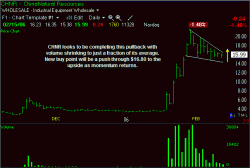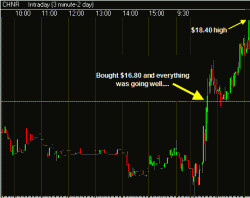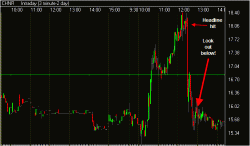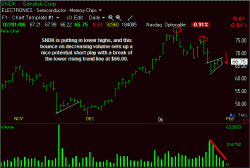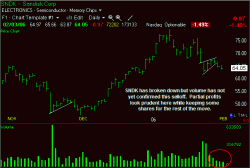Search Results for 'traders'
Good Stuff from Gartman
I believe we can learn a lot from other traders, and the mentality that keeps us willing to learn is the same one that allows us to take a small loss or book profit on the way up. We don’t need to be perfect in the trading business to do quite well! Having some trading rules in place sure can help, though.
Recently I ran across Dennis Gartman’s Rules of Trading, which I highly suggest you check out. Dennis a well-known trader and market analyst, and his rules can help any trader in any market.
My favorite rule of his?
“Do more of what is working and less of what is not working.”
Easy to remember and a great reminder to maximize winning trades and minimize the losses. Simple but not always easy!
What is your favorite trading rule?
Jeff White
President, The Stock Bandit, Inc.
www.TheStockBandit.com
Day Trading Headlines
Anytime headlines come out on a stock you’re trading, you’ll probably know it. Today I was long CHNR when a negative headline hit and this stock changed character quickly. When that happens, it’s best to remember the day trader’s motto: “sell now and ask questions later!” With commissions so cheap these days for direct access trading, it’s usually better to be safe than sorry when it comes to headlines.
I had highlighted CHNR as a long candidate in my stock newsletter last night with a buy point of $16.80. This momentum stock had settled into a powerful bull pennant pattern, and an upside breakout was the swing trading buy point.
Today, CHNR caught a bid during the morning and quickly advanced, hitting my buy point and moving higher by another 9.5% in just 2 hours time. With a nice profit on my screen in such a short amount of time, I took partial profits on the way up and had planned to ride the rest as a swing trade position.
During lunchtime, however, a headline hit the wires which was picked up by my news feed that CHNR would have to seek continued listing by filing a new listing application with Nasdaq. This was major news, and the stock began to react in a hurry. My ticker went solid red and I knew it was time to take my remaining profits now that the landscape had changed so drastically. While I don’t mind giving an active stock some room to move, it was the fact that a significant headline had come out that caused me to sell.
Keep a close eye on trades even when they are working! Don’t be afraid to take partial profits into unusual strength to book some gains, and be willing to walk away if fundamental news surfaces. The market doesn’t always act rationally, because traders will almost always sell now and ask questions later.
Jeff White
President, The Stock Bandit, Inc.
thestockbandit@thestockbandit.com
Watch Trades for Clues
Some trades are profitable while still offering us clues as to just how well they are working. While our primary objective is to turn a profit with our trades, it is certainly important to monitor the behavior of our trades to do our best to determine what we should expect going forward.
I highlighted SNDK in my stock newsletter on Wednesday night with lower highs in place and a bear flag pattern which had subsequently formed. The short selling entry point was a downside break of $66.00 at the lower line.
The following day, SNDK triggered and showed us $0.98 in profits. On Friday, it dropped another $0.97 for us, showing us a total profit per share of $1.95 from our short entry.
While I do like the fact that this short sale trade is working, I am a bit concerned by HOW it is working. Although beggars can’t be choosers, I would much prefer to have seen volume kick in with higher levels on Thursday or Friday to indicate intense selling in SNDK as it confirmed the bear flag. So far, we’ve gotten profits but it looks a bit iffy to me. As a result, I’ll plan to take partial profits to lighten up on shares in case this stock bounces. Doing so will prevent me from giving back full profits, while at the same time allowing me to stay in the trade if a larger move develops. Perhaps soon SNDK can find greater downside volume, but it’s important to operate with the facts we are given as traders, so I’m turning slightly cautious on this trade which is working but not technically sound.
Jeff White
President, The Stock Bandit, Inc.
thestockbandit@thestockbandit.com
Simplify Your Trading Layout
 Trading platforms have come a long way in just a short time. Now you can set up your trading layout just the way you want it, reflecting all kinds of information back at you to enhance your decision-making process. It’s easier than ever to monitor positions, set a quick stop-loss order, and watch multiple timeframes with several charts. But that doesn’t necessarily mean that more is better!
Trading platforms have come a long way in just a short time. Now you can set up your trading layout just the way you want it, reflecting all kinds of information back at you to enhance your decision-making process. It’s easier than ever to monitor positions, set a quick stop-loss order, and watch multiple timeframes with several charts. But that doesn’t necessarily mean that more is better!
Information overload is a widely-used term but it certainly applies to trading. I’ve known more than a few traders who suffer from paralysis by analysis. It’s easy to get so into the information that you fail to remember what it’s all there for – trading to make money! If you’re overcomplicating things and getting too wrapped up in making sure all the stars are aligned before you can pull the trigger on a good trade, then maybe it’s time to streamline your process.
Take a good look at the information your trading layout displays for you. Do you need it all? Are those indicators doing anything for you other than just adding color to the charts? Is there conflicting information which is regularly keeping you from capturing good moves in this market?
Start with the bare essentials for trading: a level 2 window, an open positions window, a chart of the futures, a chart for your stocks, and a ticker. Add only what you need to this list, and soon you’ll be able to monitor positions and market momentum without getting lost in the shuffle. Simplify your layout and spend your time and energy focusing on the tape this year rather than suffering from information overload!
Jeff White
President, The Stock Bandit, Inc.
www.TheStockBandit.com
My Biggest Trading Fear
My trading strategy is not one that will have me so exposed to any particular trade that if something bad happened I would be wiped out. Because of this, my fear isn’t that I will someday have to take a giant loss on a bad trade. Yes, I will be wrong and take my medicine, but that’s not a big concern to me.
The losing streak is the big bad ugly monster I don’t want to fall victim to. I’ve known a number of traders who allowed losing streaks to continue, and it’s scary. A losing streak leaves a trader not knowing which way is up. During a losing streak, you don’t know what to trade, when to trade, or which way to trade. You don’t know which indicators are meaningful and which are useless. Choppiness looks like a tradable pattern and what ultimately gets chopped up is your account. You’ll change your approach daily, never giving any strategy a fair evaluation. You may even start trading opposite of what you think, just to put an end to it. In short, you become clueless, and are never the same.

This is of course my 2nd biggest fear
No thank you!
Every trader needs capital to trade. Cash in an account is one type of capital, but psychological capital is certainly another equal requirement. A trader must have the courage to act on his convictions and put that cash into play. Losing streaks cost money, no doubt, but more importantly they cost a trader confidence. Money can be borrowed, but without confidence, a trader simply becomes a cash holder with no ability to seize opportunity.
Protect your confidence at all times, with as much vigilance as you protect your trading account. When you start losing money, take every measure to stop it. Cut down your trading size, trade less often, and wait for more clarity. Put on the brakes to stop a losing streak, and you’ll avoid the nasty long-term damage it can cause to your trading career.
Jeff White
President, The Stock Bandit, Inc.
www.TheStockBandit.com
Intuition or Into Wishing?
 The Market Wizards books by Jack Schwager are must-read books for traders of all kinds. These books are loaded with interviews with top traders, and it’s interesting to learn how the featured traders made it to the top of their profession.
The Market Wizards books by Jack Schwager are must-read books for traders of all kinds. These books are loaded with interviews with top traders, and it’s interesting to learn how the featured traders made it to the top of their profession.
One of the featured traders is Ed Seykota, who reportedly was up 250,000 percent between 1972 and 1988 – very much a wizard! Ed’s interview is filled with great insights as to what drives traders, and his play on words in many cases proves to be accurate. One quote that Ed makes is:
“Be sensitive to the subtle differences between ‘intuition’ and ‘into wishing.’”
What great advice! As traders, we all fight the internal battle between what our “gut” is telling us and what we want to happen based on the positions we are holding at any given time. An experienced trader should allow intuition to play a part in the decision-making process when trading, but it certainly is a fine line between what our gut tells us and what our opinions leave us hoping for!
Keep Ed’s quote on your mind and always be aware of what it is that’s driving your next trading decision. Remember, HOPE is not a trading strategy!
Jeff White
President, The Stock Bandit, Inc.
www.TheStockBandit.com
Silence is Golden
 I used to commute to a day trading office until about 2 years ago. It was good for a while but my needs changed. While I did enjoy interacting with other traders on a daily basis, it was harder at times to concentrate on the market with the sounds of a busy office. The occasional sounds coming from upset traders banging on their desks or yelling was plenty annoying. Others seemed to do more visiting than they seemed to trade. Making the move to a home office saved me some time and gas money, but it really made me a better trader.
I used to commute to a day trading office until about 2 years ago. It was good for a while but my needs changed. While I did enjoy interacting with other traders on a daily basis, it was harder at times to concentrate on the market with the sounds of a busy office. The occasional sounds coming from upset traders banging on their desks or yelling was plenty annoying. Others seemed to do more visiting than they seemed to trade. Making the move to a home office saved me some time and gas money, but it really made me a better trader.
Learning to rely on yourself as a trader is an important and ongoing lesson. While I would encourage a beginning trader to surround himself with more experienced traders, there are a number of advantages to flying solo once the learning curve passes.
I turn on CNBC some mornings just to catch up on some headlines while I am getting set up for the trading day, but once the bell rings, I rarely leave the TV on. I find the endless opinions (valuation schmaluation) to be distracting and not useful for my style of trading. Plus, their idea of “breaking news” is often too late. Instant messenger is another line of communication I typically cut off for the trading day. In the past, I’ve spent trading days chatting with other traders, but in the end I’ve found it more distracting than helpful. At times a good call was made that I might have missed, but having one more window to focus on seemed detrimental to my tape reading and trading results. Now my typical day is extremely quiet with nothing but a snoring dog and an occasional phone call which can easily be dismissed. Much better!
Cut the noise and simplify your approach with just a few nightly swing trading stock picks. Sign up for your 2-week free trial and find out which stocks I’m focusing on today!
Jeff White
President, The Stock Bandit, Inc.
www.TheStockBandit.com


